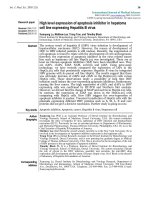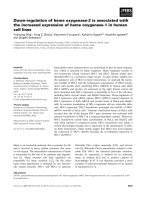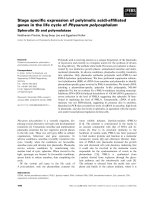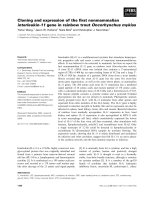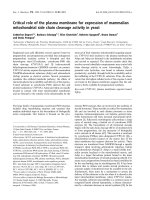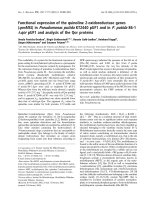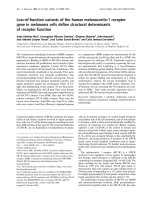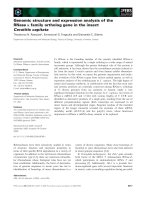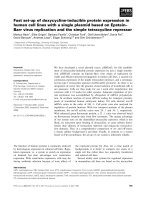Expression of bovine viral diarrhoea virus E2 gene in hela cell line
Bạn đang xem bản rút gọn của tài liệu. Xem và tải ngay bản đầy đủ của tài liệu tại đây (215.52 KB, 6 trang )
Int.J.Curr.Microbiol.App.Sci (2019) 8(10): 2145-2150
International Journal of Current Microbiology and Applied Sciences
ISSN: 2319-7706 Volume 8 Number 10 (2019)
Journal homepage:
Original Research Article
/>
Expression of Bovine Viral Diarrhoea Virus E2 Gene in HeLa Cell Line
Nitin Sharma* and Mahesh Kumar
Division of Animal Cell Culture Laboratory, Institute of Biotechnology, G.B. Pant University
of Agriculture & Technology, Patwadangar (Nainital)-263128, UK, India
*Corresponding author
ABSTRACT
Keywords
BVDV, E2,
Expression,
Eukaryotic system
Article Info
Accepted:
15 September 2019
Available Online:
10 October 2019
Bovine viral diarrhoea virus (BVDV) is the most prevalent infectious
disease of cattle. The envelope glycoprotein (E2) gene of an Indian BVDV
isolate was already cloned. In this study, recombinant plasmid
pcDNA.BVDV.E2 was used to transfect 70-80% HeLa cell, expressed E2
protein which was confirmed by immunoperoxidase test. Rabit anti mouse
HRPO conjugate was used in expression analysis and anti BVDV-E2
hyperimmune serum was raised in mice using recombinant plasmid
pcDNA.BVDV.E2 for develop specific antibody. This study demonstrates
feasibility of BVDV E2 protein expression in HeLa cell and its efficacy as
an antigen in ELISA for detecting BVDV neutralizing antibodies in cattle.
Introduction
Bovine viral diarrhoea virus (BVDV) is a
pestivirus in the family Flaviviridae and is
closely related to classical swine fever and
ovine Border disease viruses1. BVDV is a
positive-sense,
single-stranded
nonpolyadenylated RNA virus about 12.5 kb
in size with one large ORF flanked by 5' and
3' NTRs. The virion is enveloped and
spherical in shape with a diameter of 40-60
nm. Two antigenically distinct genotypes of
BVDV exist, types 1 and 2, with further
subdivisions
discernable
by
genetic
analysis2.The two genotypes may be
differentiated from each other, and from other
pestiviruses, by monoclonal antibodies
(MAbs) directed against the E2 and ERNS
major glycoproteins, or by genetic analysis3,4.
Multiplex polymerase chain reaction (PCR)
enables virus typing direct from blood
samples5. Type 1 virus is generally more
common although the prevalence of type 2 is
reported to be almost as high as type 1 in
North America. BVDV of both genotypes may
occur
in
noncytopathogenic
and
cytopathogenic forms (biotypes), classified
according to whether or not it produces visible
change in cell cultures. Usually, it is the
noncytopathogenic biotype that circulates in
2145
Int.J.Curr.Microbiol.App.Sci (2019) 8(10): 2145-2150
cattle populations. Each biotype has a specific
role in a variety of clinical syndromes– acute,
congenital and chronic infections6,7. Type 2
viruses are usually noncytopathogenic and
have been associated with outbreaks of severe
acute infection and a haemorrhagic
syndrome8. However recent type 2 viruses
isolated in the United Kingdom have been
associated with a disease indistinguishable
from that seen with the more frequently
isolated type 1 viruses. Some type 1 isolates
have been associated with particularly sever
and fatal disease outbreaks in adult cattle9
clinically mild and in apparent infections are
common with both genotypes.
Persistently viraemic healthy animals resulting
from congenital infection can be readily
identified by isolation of noncytopathogenic
virus in cell cultures from blood or serum. It is
necessary to use an immune-labelling method
to detect the growth of virus in the cultures.
Alternative methods based on direct detection
of viral antigen or viral RNA in leukocytes are
also available. Persistence of virus should be
confirmed by resampling after an interval of at
least 3 weeks. These animals will usually have
no or low levels of antibodies to BVDV.
Viraemia in acute cases is transient and can be
difficult to detect. In fatal cases of
haemorrhagic disease, virus can be isolated
from tissues post-mortem. Confirmation of
mucosal disease can be made by isolation of
the cytopathogenic biotype of BVDV,
particularly
from
intestinal
tissues.
Noncytopathogenic virus may also be
detected, especially in blood.
The most common laboratory method for this
purpose is enzyme-linked immunosorbent
assay (ELISA)10. The most immunogenic
proteins of BVDV11, including Erns and E2
structural proteins and the non-structural NS3
protein have been prepared as recombinant
proteins and applied to design ELISAs for the
detection of specific antibodies in cattle sera12.
The NS3 is an 80 kDa (p80) protein which
contains an N-terminal serine protease domain
and a C-terminal RNA helicase13. Production
of NS3 is essential for the viral RNA
replication and cytopathogenicity14. This
protein is also highly conserved among
pestiviruses and induces a strong humoral
immune response in cattle exposed to live
BVDV either naturally or by vaccination 15.
Therefore, it is a proper candidate antigen to
detect antibodies against the virus in the sera
of infected animals. For this purpose, NS3 and
NS3-specific monoclonal antibodies (MAbs)
were used to design ELISAs (indirect and
competitive ELISA) for the detection of
specific antibodies against the virus16,17,18.
During the recent years, economic impact of
BVDV infections has led a number of
countries in Europe to start eradication or
control programmes19,20. In Iran, the
prevalence of BVDV antibodies in adult cattle
is around 25.0%21,22. It is therefore desirable
to have a rapid, sensitive and reliable means of
identifying infected animals for control and
eradication of BVD. Anti-NS3 MAbs were
produced mainly following immunization with
whole virus. The main objective of this study
was to produce monoclonal antibody against
recombinant NS3 antigen of BVDV that was
produced in an efficient bacterial expression
system to design a local competitive ELISA
for detecting infected animals in future.
Materials and Methods
Recombinant plasmid
The recombinant plasmid pcDNA.BVDV.E2
was available in the Biotechnology
Laboratory, IBT, patwadangar Nainital.
Cell Line
HeLa cell line was obtained from National
centre for Cell Science (NCCS), Pune. HeLa
cell line was used in the study for in vitro
2146
Int.J.Curr.Microbiol.App.Sci (2019) 8(10): 2145-2150
expression analysis of recombinant plasmids
(pcDNA.BVDV.E2) and was maintained in
GMEM (Micro lab), supplemented with 10%
new born calf serum (Gibco, NY), penicillin
100 units/ml and streptomycin100 μg/ml.
Virus
Bovine viral diarrhoea viruses as well as BT
cell culture adapted BDV were available in the
laboratory.
Conjugates and hyperimmune serum
20 μl suspension for each wells of microtitre
plate. Added 100 μl of cell culture suspension
in each wells of 96 wells microtitter plate.
Rocked the plate gently to mix the medium,
which will become yellow-orange and turbid.
Carried out this step as quickly as possible
because the efficiency of transfection declines
rapidly once the DNA precipitate is formed.
Kept control wells without transfection.
Incubated at 370C in a humidified incubator
with an atmosphere of 5% CO2 for 72 hours.
Examined for gene expression by IPT.
Direct polyclonal antibody conjugate rabbit
anti-mouse HRPO obtained from Bangalore
Genei, Bangalore, was used in expression
analysis of pcDNA.BVDV.E2 and anti-BVDV
E2 hyperimmune serum was raise in mice
using
recombinant
plasmid
(pcDNA.BVDV.E2).
The
recombinant
plasmid (50μg/mouse) was administered
intramuscularly in thigh four times at interval
of one week, to six mice. The bold was
collected one week later from inner canthus of
eye of the mouse and serum was harvested.
Raising
primary
antibody
pcDNA.BVDV.E2 in mice
In vitro expression analysis
Immunoperoxidase test (IPT)
Transfection of HeLa cells
Cells were trypsinised using trypsin-versenate
solution (TVS) and then 4 ml of GMEM
containing 10% FCS and penicillin and
streptomycin (50 μl/ml) was added, to make
cell suspension of 1X105 cells/ml. Harvested
exponentially growing cells by trypsinization
and prepared cell suspension in growth
medium.
After 72 hours, transfected HeLa cells were
washed with 1XPBS twice and fixed with
80% chilled acetone at 40C for 10 min and airdried. Put a few drops of BVDV E2
hyperimmune serum and incubated at 370C for
1 hr and again washed with PBS, added a few
drops of horseradish- peroxidase (HRPO)
conjugated rabbit anti-mouse antibody to
wells and incubated at 370C for 1 hr in humid
chamber.
Prepared the calcium phosphate-DNA
coprecipitate as follows: combined 50 μl of
2.5M CaCl2 with 10 μl of plasmid DNA in a
sterile microfuge tube. Added 40 μl DW, kept
at room temperature. Immediately transferred
the calcium phosphate-DNA suspension using
The cells were again washed with PBS thrice
and incubated with 2-3 drops of Nadi reagent
for 5 min. After the development of color,
cells were washed with PBS, dried in air and
observed under microscope and photographed,
protocol was carried out as per23.
against
Primary polyclonal antibody against the
BVDV E2 gene was raised in mouse by hyper
immunization
of
six
mice
with
pcDNA.BVDV.E2 plasmid. 50μl of plasmid
DNA was injected IM rout in lateral region of
thigh muscles of each mouse and repeated
every week for four weeks consecutively.
Mice were bled through inner canthus of eyes
with a capillary and serum was prepared.
2147
Int.J.Curr.Microbiol.App.Sci (2019) 8(10): 2145-2150
Results and Discussion
Bovine viral diarrhoea (BVD) is one of the
most economically important infectious
diseases in cattle worldwide and the causative
agent, BVD Virus (BVDV) is a pestivirus in
the family Flaviviridae. The E2 protein is the
major target of the protective immune
response elicited against BVDV infection.
Expression of recombinant plasmid
The expression ability of recombinant
plasmids was checked by immunoperoxidase
test (IPT) in HeLa cell line and cells were
found to express the protein by development
of purple color. Intense purple coloration of
cells was observed in which HeLa cells were
transfected with pcDNA.BVDV.E2 (Fig. 1),
while healthy cell control did not show any
color change.
together with Erns and E1, forms the surface
projections protruding from the viral
envelope24. In infected cells as well as in
virions, it can be found as a homodimer of
about 100 kDa or, together with E1, as a
heterodimer of about 75 kDa. Immunostaining
of infected cells indicates that E2 and Erns are
absent from the plasma membrane25,26,27. For
expression in eukaryotic system pcDNA 3.1
vector was used which is a high level
constitutive expression vector designed for use
in variety of cells. This vector has CMV
enhancer promoter, bovine growth hormone
polyadenylation
signals,
transcription
termination sequence and SV40 origin of
episomal replication. The CMV promoter has
been reported to be very strong promoter and
has been used by many workers for high level
expression. It has also been revealed that
vectors containing the CMV promoter and
bovine growth hormone termination signal
works well in avian DNA vaccination28.
E2 is a main component of the virions and,
Fig.1 HeLa cells transfected with recombinant plasmid pcDNA.BVDV.E2 and analysed with
IPT showing purple color
HeLa cells healthy
HeLa cells transfected
The cells were transfected with recombinant
pcDNA.bdv.E2 plasmid by calcium phosphate
method29. In this method, uptake of DNA by
cultured cells is enhanced when DNA is
presented as a co-precipitate of calcium
phosphate and DNA. Replacement of medium
containing calcium phosphate with medium
having 2-5% serum was found to reduce the
toxicity of calcium phosphate co-precipitate to
the cells30. This method of transfection has
been reported to be better and also less toxic
for established cell lines 29,30. The results of
the present study would be useful for the
development of DNA vaccine against BVDV
disease.
2148
Int.J.Curr.Microbiol.App.Sci (2019) 8(10): 2145-2150
Acknowledgement
Authors thank Director, IBT, Patwadangar,
Nainital and also thank Director, IBIT
Izatnagar, Bareilly for providing facilities to
carry out this work.
References
Donis RO, Molecular biology of bovine viral
diarrhea virus and its interactions with
the host. Vet Clin North Am, 11 (1995)
393.
Vilcek S, Paton DJ, Durkovic B, Strojny L,
Ibata G, Moussa A, Loitsh A,
Rossmanith W, Vega S, Scicluna MT
& Palfi V, Bovine viral diarrhoea virus
genotype 1 can be separated into at
least eleven genetic groups. Arch
Virol, 146 (2001) 99.
Pellerin C, Vandenhurk J, Lecomte J &
Tijssen P, Identification of a new
group of bovine viral diarrhea virus
strains
associated
with
severe
outbreaks and high mortalities. Virol,
203 (1994) 260.
Ridpath JF, Bolin SR & Dubovi EJ,
Segregation of bovine viral diarrhea
virus into genotypes. Virol, 205 (1994)
66.
Gilbert SA, Burton KM, Prins SE & Deregt D,
Typing of bovine viral diarrhea viruses
directly from blood of persistently
infected cattle by multiplex PCR. J
Clin Microbiol, 37 (1999) 2020.
Bolin SR, The pathogenesis of mucosal
disease. Vet Clin North Am, 11 (1995)
489.
Browlnie J, Clinical aspects of the bovine
virus
diarrhoea/mucosal
disease
complex in cattle. In Practice, 7 (1985)
195.
Carman S, Van Dreumel T, Ridpath J, Hazlett
M, Alves D, Dubovi E, Tremblay R,
Bolin S, Godkin A & Anderson N,
Severe acute bovine viral diarrhea in
Ontario, 1993−1995. J Vet Diagn
Invest, 10 (1998) 27.
David GP, Crawshaw TR, Gunning RF,
Hibberd RC, Lloyd GM & Marsh PR,
Severe disease in adult dairy cattle in
three UK dairy herds associated with
BVD virus infection. Vet Rec, 134
(1994) 468.
Sandvik
T,
Laboratory
diagnostic
investigations
for
bovine
viral
diarrhoea virus infections in cattle. Vet
Microbiol, 64 (1999) 123.
Bolin SR, Immunogens of bovine viral
diarrhea virus. Vet microbial, 37
(1993) 263.
Chimeno Zoth S, Taboga O, Multiple
recombinant ELISA for the detection
of bovine viral diarrhoea virus
antibodies in cattle sera. J Virol
Methods, 138 (2006) 99.
Wiskerchen M, Collett MS, Pestivirus gene
expression: Protein p80 of bovine viral
diarrhea virus is a proteinase involved
in polyprotein processing. Virol, 184
(1991) 341.
Agapov EV, Murray CL, Frolov I, Uncleaved
NS2-3 is required for production of
infectious bovine viral diarrhea virus. J
Virol, 78 (2004) 2414.
Bolin S, Ridpath J, Specificity of neutralizing
and precipitating antibodies induced in
healthy
calves
by
monovalent
modified-live bovine viral diarrhea
virus vaccines. Am J Vet Res, 50
(1989) 817.
Lecomte C, Pin J, De Moerlooze L, ELISA
detection of bovine viral diarrhoea
virus specific antibodies using
recombinant antigen and monoclonal
antibodies. Vet Microbiol, 23 (1990)
193.
Reddy J, Kwang J, Okwumabua O,
Application of recombinant bovine
viral diarrhea virus proteins in the
diagnosis of bovine viral diarrhea
infection in cattle. Vet Microbiol, 57
2149
Int.J.Curr.Microbiol.App.Sci (2019) 8(10): 2145-2150
(1997) 119.
Beaudeau F, Belloc C, Seegers H, Evaluation
of a blocking ELISA for the detection
of bovine viral diarrhea virus (BVDV)
antibodies in serum and milk. Vet
Microbiol, 80 (2001) 329.
Greiser-Wilke I, Grummer B, Moennig V,
Bovine viral diarrhoea eradication and
control programmes in Europe.
Biologicals, 31 (2003) 113.
Moennig V, Houe H, Lindberg A, BVD
control in Europe: Current status and
perspectives. Anim Health Res Rev, 6
(2005) 63.
Morshedi A, Mahmudian AR, Dalir Naqadeh
B, Serological survey of cattle infected
with BVD virus by indirect ELISA and
comparison of the use of milk ELISA
and serum ELISA in Urmia. J F Vet
Med, (Tehran University) 59 (2004)
227.
Haji K, Seyfiabad SM, Serological study of
bovine viral diarrhea virus infection of
cattle in Ahvaz. J Vet Res, 62 (2007)
21.
Nakane, PK and Kawaoi A, Peroxidurelabelled antibody: A new method of
conjugate. J Histochem Cytochem, 22
(1974) 1084.
Thiel HJ, Stark R, Weiland E, Ru- menapf T
& Meyers G, Hog cholera virus:
molecular composition of virions from
a pestivirus. J Virol, 65 (1991) 4705.
Greiser-Wilke I, Dittmar KE, Liess B &
Moennig V, Immunofluorescence
studies of biotype-specific expression
of bovine viral diarrhoea virus epitopes
in infected cells. J Gen Virol, 72
(1991) 2015.
Grummer B, Beer M, Liebler-Tenorio E &
Greiser-Wilke I, Localization of viral
proteins in cells infected with bovine
viral diarrhoea virus. J Gen Virol, 82
(2001) 2597.
Weiland F, Weiland E, Unger G, Saalmuller A
& Thiel HJ, Localization of pestiviral
envelope proteins Erns and E2 at the
cell surface and on isolated particles. J
Gen Virol, 80 (1999) 1157.
Suarez DL and Schultz-Cherry S, The effect
of eukaryotic expression vectors and
adjuvants on DNA vaccines in
chickens using an avian influenza
model. Avian Diseases, 44 (2000) 861.
Sambrook J, Fritsch EF and Maniatis T,
Molecular Cloning: A Laboratory
manual (second edition). (Cold Spring
Harbour Laboratory Press), 1989.
Graham FL and van der Eb AJ, A new
technique for assay of infectivity of
human adenovirus 5 DNA. Virol, 52
(1973) 456.
How to cite this article:
Nitin Sharma and Mahesh Kumar 2019. Expression of Bovine Viral Diarrhoea Virus E2 Gene
in HeLa Cell Line. Int.J.Curr.Microbiol.App.Sci. 8(10): 2145-2150.
doi: />
2150
